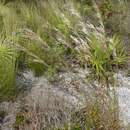Comprehensive Description
provided by North American Flora
Andropogon bakeri Scribn. & Ball, Bull. U. S. Dep. Agr
Agrost. 24: 39. 1901.
A tall tufted perennial. Stems stout, 8-12 dm. tall, much-branched above, the branches in 3's or 4's, the lower internodes much compressed; leaf -sheaths longer than the internodes, glabrous or a little hirsute, the lower ones compressed, equitant; blades up to 4 dm. long, 4-7 mm. wide, flat, a little rough above; spathes 4-5 cm. long; racemes 1.5-3 cm. long, the rachis slender, the internodes shorter than the sessile spikelets, densely clothed with silky hairs longer than themselves; sessile spikelet linear-lanceolate, 5 mm. long, the callus barbed with hairs about 2 mm. long, the first scale with hispidulous keels, the keel of the second scale also hispidulous, the fourth scale acuminate, 2-toothed at the apex, bearing a slender straight awn 6-10 mm. long; pedicellate spikelet entirely wanting, the pedicel longer than the sessile spikelet and densely clothed with long white hairs.
Type locality: Pine lands, Grasmere, Florida.
Distribution : Florida.
- bibliographic citation
- George Valentine Nash. 1912. (POALES); POACEAE (pars). North American flora. vol 17(2). New York Botanical Garden, New York, NY
Comprehensive Description
provided by North American Flora
Andropogon floridanus Sdribn. Bull. Torrey Club 23 : 145. 1896
Stems tufted, 5-16 dm. tall, much branched above the middle, the branches in I's-S's; leaf-sheaths roughish, usually shorter than the internodes; blades 5 dm. long or less, up to 1 cm. wide, rough; racemes in pairs, occasionally in 3'sor 4's, 3-4 cm. long, the pedimcle densely barbed, and exserted, or the racemes partly included at the base; sessile spikelet 3.5-4 mm. long, lanceolate, equaling or a little longer than the internodes, the first scale hispidulous on the keels above, the intercarinal space flat or somewhat depressed, the fourth scale entire, bearing an imperfect awn 8-12 mm. long; pedicellate spikelet wanting, or present as a small scale, the pedicel exceeding the sessile spikelet.
Type locality : Southern peninsular Florida. Distribution : Southern peninsular Florida.
- bibliographic citation
- George Valentine Nash. 1912. (POALES); POACEAE (pars). North American flora. vol 17(2). New York Botanical Garden, New York, NY
Physical Description
provided by USDA PLANTS text
Perennials, Terrestrial, not aquatic, Rhizomes present, Stems nodes swollen or brittle, Stems erect or ascending, Stems geniculate, decumbent, or lax, sometimes rooting at nodes, Stems caespitose, tufted, or clustered, Stems terete, round in cross section, or polygonal, Stems branching above base or distally at nodes, Stem internodes solid or spongy, Stems with inflorescence less than 1 m tall, Stems with inflorescence 1-2 m tall, Stems, culms, or scapes exceeding basal leaves, Leaves mostly basal, below middle of stem, Leaves mostly cauline, Leaves conspicuously 2-ranked, distichous, Leaves sheathing at base, Leaf sheath mostly open, or loose, Leaf sheath smooth, glabrous, Leaf sheath hairy, hispid or prickly, Leaf sheath and blade differentiated, Leaf blades linear, Leaf blades 2-10 mm wide, Leaf blades mostly flat, Leaf blade margins folded, involute, or conduplicate, Leaf blades mostly glabrous, Leaf blades scabrous, roughened, or wrinkled, Ligule present, Ligule an unfringed eciliate membrane, Ligule a fringed, ciliate, or lobed membrane, Inflorescence terminal, Inflorescence solitary, with 1 spike, fascicle, glomerule, head, or cluster per stem or culm, Inflorescence a panicle with narrowly racemose or spicate branches, Inflorescence with 2-10 branches, Inflorescence branches paired racemes, V-shaped, Flowers bisexual, Flowers unisexual, Spikelets pedicellate, Spikelets sessile or subsessile, Spikelets laterally compressed, Spikelet less than 3 mm wide, Spikelets with 2 florets, Spikelets paired at rachis nodes, Spikelets in paired units, 1 sessile, 1 pedicellate, Pedicellate spikelet rudimentary or absent, usually sterile, Spikelets bisexual, Spikelets unisexual, Inflorescence disarticulating between nodes or joints of rachis, rachis fragmenting, Spikelets disarticulating below the glumes, Spikelets falling with parts of disarticulating rachis or pedicel, Glumes present, empty bracts, Glumes 2 clearly present, Glumes equal or subequal, Glumes equal to or longer than adjacent lemma, Glumes keeled or winged, Glume surface hairy, villous or pilose, Lemmas thin, chartaceous, hyaline, cartilaginous, or membranous, Lemma 1 nerved, Lemma 3 nerved, Lemma glabrous, Lemma apex dentate, 2-fid, Lemma distinctly aw ned, more than 2-3 mm, Lemma with 1 awn, Lemma awn less than 1 cm long, Lemma awn 1-2 cm long, Lemma awn from sinus of bifid apex, Lemma awns straight or curved to base, Lemma awn once geniculate, bent once, Lemma margins thin, lying flat, Lemma straight, Callus or base of lemma evidently hairy, Callus hairs shorter than lemma, Stamens 1, Styles 2-fid, deeply 2-branched, Stigmas 2, Fruit - caryopsis.

